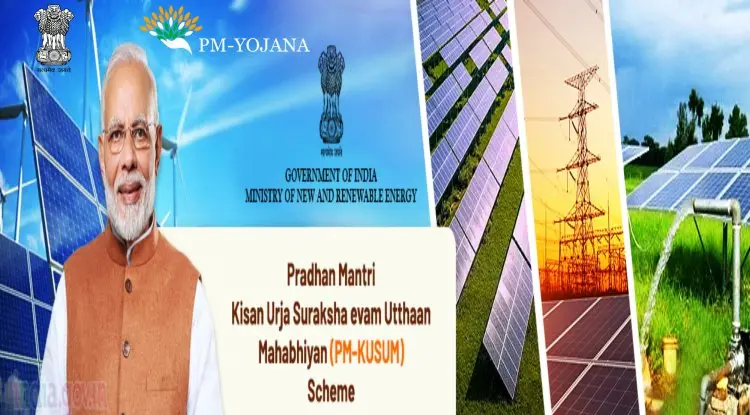Kusum Scheme
Kusum Yojana was launched by the Government of India to increase the income of farmers and provide sources for irrigation and de-dieselising .

Kusum Scheme
Kusum Yojana was launched by the Government of India to increase the income of farmers and provide sources for irrigation and de-dieselising .
PM Kusum Scheme
What is PM-KUSUM Scheme?
The PM-KUSUM or Pradhan Mantri Kisan Urja Suraksha Utthan Mahabhiyan scheme is an initiative launched by the Government of India under the aegis of the Ministry of New and Renewable energy (MNRE) in 2019. The scheme’s objective is to provide assistance installing off-grid solar pumps on village land (rural areas) and thus decrease their dependence on the grid. It is valid for grid-connected areas.
The idea is to increase farmers’ income by selling extra electricity generated and reducing the over-dependence of farmers on diesel. The scheme was launched by the Ministry of New and Renewable energy across the nation.
Name of Scheme- Kusum Yojana
Launched by- Former Finance Minister– Arun Jaitley
Ministry- Ministry of Agriculture & Energy
Beneficiaries- Country farmers
Major Benefit- Providing Solar irrigation pump
Scheme Objective- Solar Irrigation pumps at Discounted prices
Scheme under- State Government
Name of State- Pan India
Post Category- Scheme/ Yojana
Aim of the KUSUM Scheme
Through this scheme, the government plans to add 25,750 MW of solar electricity by 2022. The Central government plans to infuse Rs. 34,422 crores in this scheme.
Objectives of the KUSUM Scheme
Under the scheme, farmers, cooperative societies, farmers-cooperative groups, and panchayats can apply to install solar pumps. The total cost incurred in implementing the project is so planned that the farmers’ financial burden is negligible. The overall cost is divided into three categories:
- Government to provide a 60% subsidy directly to farmers
- 30% will be provided through soft loans to farmers
- 10% actual cost to be incurred by farmers.
Components of PM-KUSUM Scheme
There are three main components of the KUSUM scheme:
- Component A – The scheme plans to add 10000 MW of Renewable power by establishing individual renewable power plants up-to 2 MW size. These power plants are to be decentralized, ground-mounted, and connected to the grid. These are to be set up on barren land and should come up within a 5km radius of the sub-station.
- Component B – To install, 17.50 lakh standalone off the grid Solar Powered Agriculture Pumps with an individual capacity of the pump up-to 7.5 HP. It is meant to replace existing diesel pumps already in use. A farmer can install a higher capacity pump, but the financial assistance will only be granted to a 7.5 HP agriculture pump.
- Component C – To solarize 10 lakh on-grid or grid-connected agriculture pumps with individual pump capacity up-to 7.5 HP. The excess electricity generated from these plants will be sold to the respective DISCOMS on pre-fixed tariff bases.
How to implement the KUSUM scheme?
For implementing the KUSUM scheme, the State Nodal Agencies of MNRE will coordinate with respective States/UTs, Discoms, and farmers.
The components A and C under the scheme are to be implemented only in Pilot mode until 31st December 2019. On successful implementation of the Pilot project, the two components of the scheme will be further scaled up, after receiving necessary approvals.
Component B of the scheme, an ongoing sub-program is to be implemented in its entirety without any requirement of a Pilot project.
Implementation
Component A:
- Individual farmers, farmer groups, panchayats, cooperative societies, or farmer producer organizations can set up renewable power plants with 500 KW to 2 MW capacity. In case of failure to arrange funds, the above entities can collaborate with interested developers or with local DISCOMS to establish renewable power plants.
- Once operational, the DISCOMS will notify regarding sub-station wise surplus power that can be fed to the grid through these renewable projects.
- The surplus renewable power thus generated will be purchased on a feed-in tariff basis by local DISCOMS. The tariff is to be determined and fixed by the State Electricity Regulatory Commission.
- The DISCOMS are eligible for Procurement Based Incentive (PBI) @ 40 paise per kWh or Rs 6.60 lakh per MW installed capacity per year, whichever is lower for five years.
Component B:
- For standalone power pumps with 7.5 HP capacity, central financial assistance would be 30% of the tender cost or benchmark cost. The State government will provide a 30% subsidy, and another 30% will be arranged for farmers through Banks in the form of loans. Farmers will chip in with only 10% of the actual cost of the project.
- In the North East, Himachal Pradesh, Uttarakhand, J&K, Andaman and Nicobar Islands, the Central assistance will be 50% of the tender cost or the benchmark cost, while 30% will be in the form of subsidy provided by State government. The rest 20% will be arranged by the farmer with loans up to 10% by banks and farmers, putting in 10% of the actual cost.
Component C:
- The financial assistance provided to farmers in this grid-connected agriculture pump will be similar to component B. 30% cost will be CFA. In comparison, another 30% by the respective State government and out of rest 40%, Banks will provide loans for 30%, and the farmer has to arrange only 10% of the project’s cost.
- For North-east, Himachal, Uttarakhand, Andaman & Nicobar Islands, 50% project cost will be funded by Central government, rest 30 % by State, and 10% cost is to be given as loan by banks. The farmers have to bear only 10% of the project cost.
Beneficiary
The scheme aims to provide stable and continuous income to farmers or rural landowners for 25 years. It will be put to good use of the barren or uncultivated land. In the case of cultivated land, solar panels are installed at a height that doesn’t disrupt farming.
While providing a regular supply of electricity during the day to agricultural land, the close vicinity of the projects to sub-stations ensures low transmission loss to DISCOMS. It will wean away farmers from using diesel, another positive or win-win situation for the environment and the economy.
To increase farmer’s income and reduce their over-dependence on diesel, the KUSUM scheme was launched. The scheme puts to use the barren land in rural areas and cultivable fields for producing renewable energy. With the government’s financial assistance, both State and Central, the farmers’ financial burden is kept to the minimum. The KUSUM scheme can transform the rural economy for the better and improve the economic conditions of the farmers substantially.
What is the cost distribution to establish a solar plant?
The cost distribution is as follows;
|
Central and State Government |
60% subsidy |
|
Banks |
30% as loans to farmers |
|
Farmers |
10% of the actual cost |
Background
- As a part of Intended Nationally Determined Contributions (INDCs), India has committed to increase the share of installed capacity of electric power from non-fossil-fuel sources to 40% by 2030.
- The Cabinet had approved scaling-up of solar power target from 20,000 MW of Grid Connected Solar power Projects to 1,00,000 MW by 2022.
Latest information on PM KUSUM Scheme –
- The farmer focus of the KUSUM scheme has given a fillip to the farmer-oriented scheme involving decentralized solar power production up to 28,250 MW over a period of five years.
- The Kisan Urja Suraksha evam Utthaan Mahabhiyan (KUSUM) scheme would provide additional income to farmers, by giving them the option to sell additional power to the grid, through solar power projects set up on their barren lands.
- The government’s Budget for 2020-21 expanded the scope for the scheme with 20 lakh farmers to be provided assistance to install standalone solar pumps; another 15 lakh farmers to be given help to solarise their grid-connected pump sets. This will enable farmers to set up solar power generation capacity on their barren lands and to sell it to the grid.







